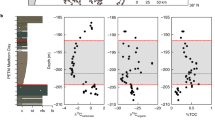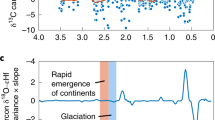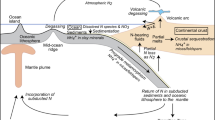Abstract
Deep carbon recycling is an essential part of the global carbon cycle. The carbonates at the bottom of the ocean are brought to the mantle by subduction. Subsequently, deep carbon is released to the atmosphere in the form of CO2 through volcanism. At present, research on deep carbon recycling is still at its early stage. The proportion of subduction-related carbon and primary mantle-derived carbon in CO2 released by volcano is an important issue. Carbon isotopes can easily distinguish organic carbon from inorganic carbon. However, ∼95% of subduction-related and primary mantle-derived carbon released by volcano is inorganic, which carbon isotopes find difficult to distinguish. Recently, Ca and Mg isotope geochemistry has provided important tools for tracing crust-derived material recycling. Here we focus on this topic by introducing the principles of C, Ca, and Mg isotopes in tracing deep carbon recycling and previous research results. We also summarize the research progress on the total storage and phases of deep carbon, CO2 fluxes which depend on the release via volcanism, the partial melting of the carbon-bearing mantle, and carbon behaviour during oceanic subduction.
Similar content being viewed by others
References
Wang P X. Earth system science in China quo vad is (in Chinese)? Adv in Earth Sci, 2003, 18: 837–851
Qu J S, Sun C Q, Zhang Z Q, et al. Trends and advances of the global chance studies on carbon cycle (in Chinese). Adv in Earth Sci, 2003, 18: 980–987
Deines P. The carbon isotope geochemistry of mantle xenoliths. Earth Sci Rev, 2002, 58: 247–278
Huang S C, Farkaš J, Jacobsen S B. Stable calcium isotopic compositions of Hawaiian shield lavas: Evidence for recycling of ancient marine carbonates into the mantle. Geochim Cosmochim Acta, 2011, 75: 4987–4997
Li W Y, Teng F Z, Ke S, et al. Heterogeneous magnesium isotopic composition of the upper continental crust. Geochim Cosmochim Acta, 2010, 74: 6867–6884
Bureau H, Pineau F, Métrich N, et al. A melt and fluid inclusion study of the gas phase at Piton de la Fournaise volcano (Réunion Island). Chem Geol, 1998, 147: 115–130
Cartigny P, Jendrzejewski N, Pineau F, et al. Volatile (C, N, Ar) variability in MORB and the respective roles of mantle source heterogeneity and degassing: The case of the Southwest Indian Ridge. Earth Planet Sci Lett, 2001, 194: 241–257
Saal A E, Hauri E H, Langmuir C H, et al. Vapour undersaturation in primitive mid-ocean-ridge basalt and the volatile content of Earth’s upper mantle. Nature, 2002, 419: 451–455
Aubaud C, Pineau F, Hékinian R, et al. Degassing of CO2 and H2O in submarine lavas from the Society hotspot. Earth Planet Sci Lett, 2005, 235: 511–527
Cartigny P, Pineau F, Aubaud C, et al. Towards a consistent mantle carbon flux estimate: Insights from volatile systematics (H2O/Ce, δD, CO2/Nb) in the North Atlantic mantle (14°N and 34°N). Earth Planet Sci Lett, 2008, 265: 672–685
Shaw A M, Behn M D, Humphris S E, et al. Deep pooling of low degree melts and volatile fluxes at the 85°E segment of the Gakkel Ridge: Evidence from olivine-hosted melt inclusions and glasses. Earth Planet Sci Lett, 2010, 289: 311–322
Dasgupta R, Hirschmann M M. The deep carbon cycle and melting in Earth’s interior. Earth Planet Sci Lett, 2010, 298: 1–13
Hirschmann M M, Dasgupta R. The H/C ratios of Earth’s near-surface and deep reservoirs, and consequences for deep Earth volatile cycles. Chem Geol, 2009, 262: 4–16
Yoder C F. Astrometric and geodetic properties of Earth and the solar system. In: Ahrens T J, ed. Global Earth Physics: A Handbook of Physical Constants, AGU Reference Shelf. Washington D C: American Geophysical Union, 1995. 1–31
McDonough W F. Compositional Model for the Earth’s Core. In: Holland H D, Turrekian K K, eds. Treatise on Geochemistry. Amsterdam: Elsevier, 2004. 547–568
Shcheka S S, Wiedenbeck M, Frost D J, et al. Carbon solubility in mantle minerals. Earth Planet Sci Lett, 2006, 245: 730–742
Liu L G, Mernagh T P. Phase transitions and Raman spectra of calcite at high pressures and room temperature. Am Mineral, 1990, 75: 801–806
Dalton J A, Presnall D C. Carbonatitic melts along the solidus of model lherzolite in the system CaO-MgO-Al2O3-SiO2-CO2 from 3 to 7 GPa. Contrib Mineral Petrol, 1998, 131: 123–135
Hammouda T. High-pressure melting of carbonated eclogite and experimental constraints on carbon recycling and storage in the mantle. Earth Planet Sci Lett, 2003, 214: 357–368
Yaxley G M, Brey G P. Phase relations of carbonate-bearing eclogite assemblages from 2.5 to 5.5 GPa: Implications for petrogenesis of carbonatites. Contrib Mineral Petrol, 2004, 146: 606–619
Dasgupta R, Hirschmann M M, Dellas N. The effect of bulk composition on the solidus of carbonated eclogite from partial melting experiments at 3 GPa. Contrib Mineral Petrol, 2005, 149: 288–305
Thomsen T B, Schmidt M W. Melting of carbonated pelites at 2.5–5.0 GPa, silicate-carbonatitie liquid immiscibility, and potassium-carbon metasomatism of the mantle. Earth Planet Sci Lett, 2008, 267: 17–31
Wallace M E, Green D H. An experimental determination of primary carbonatite magma composition. Nature, 1988, 335: 343–346
Falloon T J, Green D H. The solidus of carbonated, fertile peridotite. Earth Planet Sci Lett, 1989, 94: 364–370
Falloon T J, Green D H. Solidus of carbonated fertile peridotite under fluid-saturated conditions. Geology, 1990, 18: 195–199
Dasgupta R, Hirschmann M M, Withers A C. Deep global cycling of carbon constrained by the solidus of anhydrous, carbonated eclogite under upper mantle conditions. Earth Planet Sci Lett, 2004, 227: 73–85
Dasgupta R, Hirschmann M M. Melting in the Earth’s deep upper mantle caused by carbon dioxide. Nature, 2006, 440: 659–662
Dasgupta R, Hirschmann M M. Effect of variable carbonate concentration on the solidus of mantle peridotite. Am Mineral, 2007, 92: 370–379
Dasgupta R, Hirschmann M M. A modified iterative sandwich method for determination of near-solidus partial melt compositions. III. Application to determination of near-solidus melt compositions of carbonated peridotite. Contrib Mineral Petrol, 2007, 154: 647–661
Brey G P, Bulatov V K, Girnis A V, et al. Experimental melting of carbonated peridotite at 6–10 GPa. J Petrol, 2008, 49: 797–821
Ghosh S, Ohtani E, Litasov K D, et al. Solidus of carbonated peridotite from 10 to 20 GPa and origin of magnesiocarbonatite melt in the Earth’s deep mantle. Chem Geol, 2009, 262: 17–28
Litasov K D, Ohtani E. Solidus and phase relations of carbonated peridotite in the system CaO-Al2O3-MgO-SiO2-Na2O-CO2 to the lower mantle depths. Phys Earth Planet Interiors, 2009, 177: 46–58
Tsuno K, Dasgupta R. Melting phase relation of nominally anhydrous, carbonated pelitic-eclogite at 2.5–3.0 GPa and deep cycling of sedimentary carbon. Contrib Mineral Petrol, 2011, 161: 743–763
Woodland A B, Koch M. Variation in oxygen fugacity with depth in the upper mantle beneath the Kaapvaal craton, South Africa. Earth Planet Sci Lett, 2003, 214: 295–310
Frost D J, McCammon C A. The redox state of the Earth’s mantle. Annu Rev Earth Planet Sci, 2008, 36: 389–420
Stagno V, Frost D J. Carbon speciation in the asthenosphere: Experimental measurements of the redox conditions at which carbonate-bearing melts coexist with graphite or diamond in peridotite assemblages. Earth Planet Sci Lett, 2010, 300: 72–84
Rohrbach A, Schmidt M W. Redox freezing and melting in the Earth’s deep mantle resulting from carbon-iron redox coupling. Nature, 2011, 472: 209–212
Yin Q P. How is the diamand created (in Chinese). Jewel Sci Technol, 2004, 16: 44–50
Lowenstern J B. Carbon dioxide in magmas and implications for hydrothermal systems. Miner Depos, 2001, 36: 490–502
Dixon J E. Degassing of alkalic basalts. Am Mineral, 1997, 82: 368–378
Lesne P, Scaillet B, Pichavant M, et al. The carbon dioxide solubility in alkali basalts: An experimental study. Contrib Mineral Petrol, 2011, 162: 153–168
Rea D K, Ruff L J. Composition and mass flux of sediment entering the world’s subduction zones: Implications for global sediment budgets, great earthquakes, and volcanism. Earth Planet Sci Lett, 1996, 140: 1–12
Shen X J, Zhang L F. Current research progress in petrology of carbonated eclogites (in Chinese). Earth Sci Front, 2009, 16: 374–384
Johnston F K B, Turchyn A V, Edmonds M. Decarbonation efficiency in subduction zones: Implications for warm Cretaceous climates. Earth Planet Sci Lett, 2011, 303: 143–152
Plank T, Langmuir C H. The chemical composition of subducting sediment and its consequences for the crust and mantle. Chem Geol, 1998, 145: 325–394
Carlson R L, Herrick C N. Densities and porosities in the oceanic crust and their variations with depth and age. J Geophys Res, 1990, 95: 9153–9170
Reymer A, Schubert G. Phanerozoic addition rates to the continental crust and crustal growth. Tectonics, 1984, 3: 63–77
Marty B, Tolstikhin I N. CO2 fluxes from mid-ocean ridges, arcs and plumes. Chem Geol, 1998, 145: 233–248
Wang C Y. Density and constitution of the mantle. J Geophys Res, 1970, 75: 3264–3284
Hayes J M, Waldbauer J R. The carbon cycle and associated redox processes through time. Phil Trans R Soc B, 2006, 361: 931–950
Hilton D R, Fischer T P, Marty B. Noble gases and volatile recycling at subduction zones. Rev Mineral Geochem, 2002, 47: 319–370
Sano Y, Williams S N. Fluxes of mantle and subducted carbon along convergent plate boundaries. Geophys Res Lett, 1996, 23: 2749–2752
Ingebritsen S E, Manning C E. Diffuse fluid flux through orogenic belts: Implications for the world ocean. Proc Nat Acad Sci USA, 2002, 99: 9113–9116
Blundy J, Cashman K V, Rust A, et al. A case for CO2-rich arc magmas. Earth Planet Sci Lett, 2010, 290: 289–301
Bulanova G P, Walter M J, Smith C B, et al. Mineral inclusions in sublithospheric diamonds from Collier 4 kimberlite pipe, Juina, Brazil: subducted protoliths, carbonated melts and primary kimberlite magmatism. Contrib Mineral Petrol, 2010, 160: 489–510
Muehlenbachs K, Byerly G. 18O-Enrichment of silicic magmas caused by crystal fractionation at the Galapagos Spreading Center. Contrib Mineral Petrol, 1982, 79: 76–79
Teng F Z, Dauphas N, Helz R T. Iron isotope fractionation during magmatic differentiation in Kilauea Iki lava lake. Science, 2008, 320: 1620–1622
Schuessler J A, Schoenberg R, Sigmarsson O. Iron and lithium isotope systematics of the Hekla volcano, Iceland-Evidence for Fe isotope fractionation during magma differentiation. Chem Geol, 2009, 258: 78–91
Teng F Z, Wadhwa M, Helz R T. Investigation of magnesium isotope fractionation during basalt differentiation: Implications for a chondritic composition of the terrestrial mantle. Earth Planet Sci Lett, 2007, 261: 84–92
Liu S A, Teng F Z, He Y S, et al. Investigation of magnesium isotope fractionation during granite differentiation: Implication for Mg isotopic composition of the continental crust. Earth Planet Sci Lett, 2010, 297: 646–654
Amini M, Eisenhauer A, Böhm F, et al. Calcium isotopes (δ 44/40Ca) in MPI-DING reference glasses, USGS rock powders and various rocks: Evidence for Ca isotope fractionation in terrestrial silicates. Geostand Geoanal Res, 2009, 33: 231–247
Schidlowski M. A 3800-million-year isotopic record of life from carbon in sedimentary rocks. Nature, 1988, 333: 313–318
Cartigny P. Stable isotopes and the origin of diamond. Elements, 2005, 1: 79–84
Walter M J, Kohn S C, Araujo D, et al. Deep mantle cycling of oceanic crust: Evidence from diamonds and their mineral inclusions. Science, 2011, 334: 54–57
Lupton J E. Terrestrial inert gases-Isotope tracer studies and clues to primordial components in the mantle. Ann Rev Earth Planet Sci, 1983, 11: 371–414
Sano Y, Marty B. Origin of carbon in fumarolic gas from island arcs. Chem Geol, 1995, 119: 265–274
Sano Y, Gamo T, Williams S N. Secular variations of helium and carbon isotopes at Galeras volcano, Colombia. J Volcanol Geotherm Res, 1997, 77: 255–265
Hilton D R, Craig H. A helium isotope transect along the Indonesian archipelago. Nature, 1989, 342: 906–908
Milliman J D. Production and accumulation of calcium carbonate in the ocean: Budget of a nonsteady state. Global Biogeochem Cycles, 1993, 7: 927–957
Chang V T C, Williams R J P, Makishima A, et al. Mg and Ca isotope fractionation during CaCO3 biomineralisation. Biochem Biophys Res Commun, 2004, 323: 79–85
Galy A, Yoffe O, Janney P E, et al. Magnesium isotope heterogeneity of the isotopic standard SRM980 and new reference materials for magnesium-isotope-ratio measurements. J Anal At Spectrom, 2003, 18: 1352–1356
Wombacher F, Eisenhauer A, Böhm F, et al. Magnesium stable isotope fractionation in marine biogenic calcite and aragonite. Geochim Cosmochim Acta, 2011, 75: 5797–5818
Li W Y, Teng F Z, Xiao Y L, et al. High-temperature inter-mineral magnesium isotope fractionation in eclogite from the Dabie orogen, China. Earth Planet Sci Lett, 2011, 304: 224–230
Chavagnac V, Jahn B M. Coesite-bearing eclogites from the Bixiling complex, Dabie Mountains, China: Sm-Nd ages, geochemical characteristics and tectonic implications. Chem Geol, 1996, 133: 29–51
Zhang R Y, Liou J G, Cong B L. Talc-, magnesite- and Ti-clinohumite-bearing ultrahigh-pressure meta-mafic and ultramafic complex in the Dabie Mountains, China. J Petrol, 1995, 36: 1011–1037
Yang W, Teng F Z, Zhang H F, et al. Magnesium isotopic systematics of continental basalts from the North China craton: Implications for tracing subducted carbonate in the mantle. Chem Geol, 2012, doi: 10.1016/j.chemgeo.2012.05.018
Anderson D L. Chemical composition of the mantle. J Geophys Res, 1983, 88(Suppl): B41–B52
Eisenhauer A, Nägler T F, Stille P, et al. Proposal for an international agreement on Ca notation as a result of the discussion from the workshop on stable isotope measurements in Davos (Goldschmidt 2002) and Nice (EGS-AGU-EUG 2003). Geostand Geoanal Res, 2004, 28: 149–151
Farkaš J, Buhl D, Blenkinsop J, et al. Evolution of the oceanic calcium cycle during the late Mesozoic: Evidence from δ 44/40Ca of marine skeletal carbonates. Earth Planet Sci Lett, 2007, 253: 96–111
Holmden C. Ca isotope study of Ordovician dolomite, limestone, and anhydrite in the Williston Basin: Implications for subsurface dolomitisation and local Ca cycling. Chem Geol, 2009, 268: 180–188
DePaolo D J. Calcium isotopic variations produced by biological, kinetic, radiogenic and nucleosynthetic processes. Rev Mineral Geochem, 2004, 55: 255–288
Huang S C, Farkaš J, Jacobsen S B. Calcium isotopic fractionation between clinopyroxene and orthopyroxene from mantle peridotites. Earth Planet Sci Lett, 2010, 292: 337–344
Simon J I, DePaolo D J. Stable calcium isotopic composition of meteorites and rocky planets. Earth Planet Sci Lett, 2010, 289: 457–466
De La Rocha C L, DePaolo D J. Isotopic evidence for variations in the marine calcium cycle over the Cenozoic. Science, 2000, 289: 1176–1178
Fantle M S, DePaolo D J. Variations in the marine Ca cycle over the past 20 million years. Earth Planet Sci Lett, 2005, 237: 102–117
Gussone N, Böhm F, Eisenhauer A, et al. Calcium isotope fractionation in calcite and aragonite. Geochim Cosmochim Acta, 2005, 69: 4485–4494
Author information
Authors and Affiliations
Corresponding author
Rights and permissions
About this article
Cite this article
Zhang, H., Li, S. Deep carbon recycling and isotope tracing: Review and prospect. Sci. China Earth Sci. 55, 1929–1941 (2012). https://doi.org/10.1007/s11430-012-4532-y
Received:
Accepted:
Published:
Issue Date:
DOI: https://doi.org/10.1007/s11430-012-4532-y




